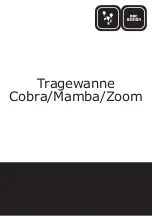
Page 12/82
A
MPLIFIER
S
ELECTION FOR USE WITH
PS-S
ERIES
3
A
MPLIFIER
S
ELECTION FOR USE WITH
PS-S
ERIES
NEXO recommends high power amplifiers in all cases. Budget constraints are the only reason to select
lower power amplifiers. A lower power amplifier will not reduce the chances of driver damage due to
over-excursion, and may actually increase the risk of thermal damage due to sustained clipping. If an
incident occurs on an installation without protection, the fact that amplifiers only generating half their
rated output power (-3dB) are used will not change anything in respect of possible damage. This is due
to the fact that the RMS power handling of the weakest component in the system is always 6 to 10 dB
lower than the amplifier rating.
3.1 PS and LS recommended amplification
Nexo recommends amplifiers in agreement with table below:
Recommended
Amplifier#
Channel 1
LF in Active Mode or
LF+HF in Passive Mode
Channel 2
HF in Active Mode
LS400
300 to 700 W / 6 Ohms
PS8
200 to 500 W / 8 Ohms
LS600
1000 to 2000 W / 8 Ohms
PS10R2
500 to 1250 W / 8 Ohms
PS15R2 Passive Mode
1000 to 2000 W / 8 Ohms
PS15R2 Active Mode
1000 to 2000 W / 8 Ohms
250 to 500 W / 16 Ohms
3.1.1 Current rating
It is very important that the amplifier behaves correctly under low load conditions. A speaker system is
reactive by nature: on transient signals like music it will require four to ten times more instantaneous
current than its nominal impedance would indicate. Amplifiers are generally specified by continuous
RMS power into resistive loads, however the only useful information about current capacity is the
specification into a 2 Ohm load. It is possible to perform an amplifier listening test by loading the amps
with twice the number of cabinets considered for the application (2 speakers per channel instead of one,
4 instead of 2) and running the amps up to the onset of clipping. If the signal does not noticeably
deteriorate, the amplifier is well adapted (overheating after approximately ten minutes is normal but
thermal protection must not operate too quickly after starting this test).
3.1.2 Amplifier settings
Gain value
Gain is the key to correct alignment of the system. It is especially important to know the gain of all
amplifiers used in your set-up. The tolerance should be about ±0.5 dB. In practice this can be difficult to
achieve because:
Some amplifier brands have an identical input sensitivity for models of different power rating (this
infers a different voltage gain for each model). For example, a range of amplifiers with different
power outputs, all having a published input sensitivity of 775mV/0dBm or 1.55V/+6dBm, will have
a wide range of actual gains
– the higher the power, the greater the gain.
Various other brands may offer constant gain but only within a given product range, for example
they may fit fixed input sensitivity only on their semi-professional amps.
Even if a manufacturer applies the constant gain rule to all models, the value selected will not
necessarily be the same as that chosen by other manufacturers.
Summary of Contents for PS Series
Page 17: ...CONNECTION DIAGRAMS Page 17 82 5 CONNECTION DIAGRAMS 5 1 PS8 LS400 with PS8 TDController ...
Page 18: ...Page 18 82 CONNECTION DIAGRAMS 5 2 PS8 LS400 with NXAMP4x1 ...
Page 19: ...CONNECTION DIAGRAMS Page 19 82 5 3 PS8 LS400 with NXAMP4x4 ...
Page 20: ...Page 20 82 CONNECTION DIAGRAMS 5 4 PS10 LS600 with PS10 TDController ...
Page 21: ...CONNECTION DIAGRAMS Page 21 82 5 5 PS10 LS600 with NXAMP4x1 ...
Page 22: ...Page 22 82 CONNECTION DIAGRAMS 5 6 PS10 LS600 with NXAMP4x4 ...
Page 23: ...CONNECTION DIAGRAMS Page 23 82 5 7 PS15 Passive RS15 Omni with PS15 TDController ...
Page 24: ...Page 24 82 CONNECTION DIAGRAMS 5 8 PS15 Passive RS15 Omni with NXAMP4x1 ...
Page 25: ...CONNECTION DIAGRAMS Page 25 82 5 9 PS15 Passive RS15 Omni with NXAMP4x4 ...
Page 26: ...Page 26 82 CONNECTION DIAGRAMS 5 10 PS15 Active with NXAMP4x4 ...
Page 56: ...Page 56 82 TECHNICAL SPECIFICATIONS 9 1 2 Dimensions ...
Page 59: ...TECHNICAL SPECIFICATIONS Page 59 82 9 2 2 Dimensions ...
Page 62: ...Page 62 82 TECHNICAL SPECIFICATIONS 9 3 2 Dimensions ...
Page 66: ...Page 66 82 TECHNICAL SPECIFICATIONS 9 5 2 U Bracket for PS10R2 VNT SSBRK10 Parts Dimensions ...
Page 67: ...TECHNICAL SPECIFICATIONS Page 67 82 9 5 3 U Bracket for PS15R2 VNT SSBRK15 Parts Dimensions ...
Page 73: ...TECHNICAL SPECIFICATIONS Page 73 82 9 6 2 PS10R2 U Bracket VNI UBRK10 Parts Dimensions ...
Page 74: ...Page 74 82 TECHNICAL SPECIFICATIONS 9 6 3 PS15R2 U Bracket VNI UBRK12 Parts Dimensions ...













































